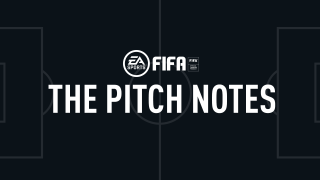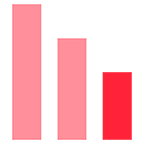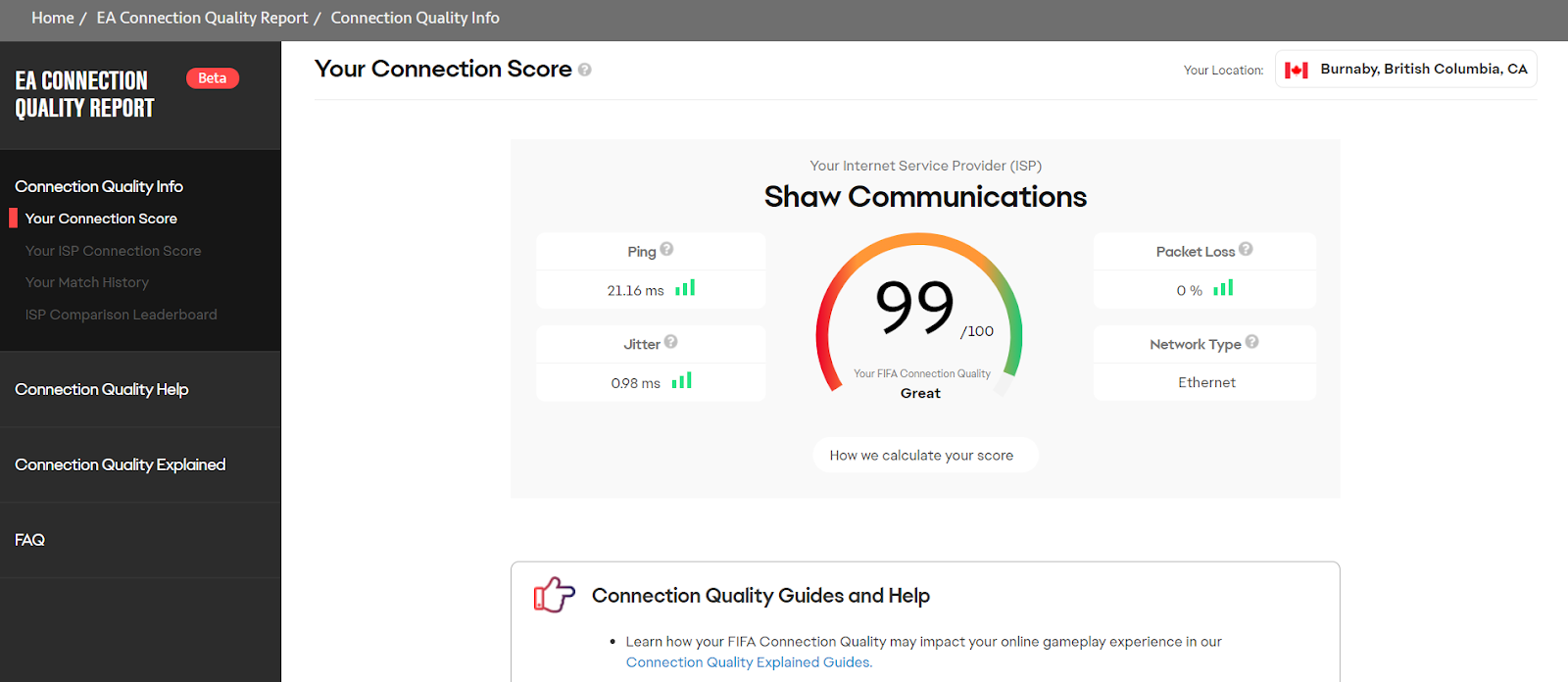
Actualización sobre los tiempos de respuesta del juego (nov. 2020)
Monitoreo de la conexión, informe de calidad de conexión de EA y nuevo FGDC en Miami.
Notas a pie de cancha

17 de noviembre de 2020

Hola a todos:
Mi nombre es Joel Doonan y soy el jefe de producción del equipo Player First Operations, parte del equipo de FIFA Live.
Antes de empezar a analizar las actualizaciones contempladas en estas Notas a pie de cancha, quiero enviarles a todos mis mejores deseos de salud y bienestar en estos tiempos difíciles. Espero que ustedes y sus familias estén bien.
Pasaron unos meses desde la última vez que hablamos de los temas relacionados con el trabajo del equipo de Desarrollo de FIFA en los tiempos de respuesta del juego online. Como dijimos en otras ocasiones, esto fue y sigue siendo una prioridad para nosotros.
A nivel general, el trabajo se concentró en dos áreas: infraestructura interna y educación e información externas. Hoy me complace poder informarles acerca de las actualizaciones en las siguientes capacidades que ya están disponibles:
Infraestructura:
- Nuevo centro de datos de juego de FIFA (FGDC) en Miami
Información/educación:
- Monitoreo de la conexión
- Informe de calidad de conexión
Dicho esto, comencemos.
En síntesis:
- El nuevo FGDC ya está operativo en Miami, Florida.
- Tiene como objetivo mejorar la experiencia de los jugadores de Centroamérica y del norte de Sudamérica, además del sureste de los Estados Unidos.
- El monitoreo de la conexión ya está disponible para usar en FIFA 21.
- Aquí encontrarán más información.
- El informe de calidad de conexión está disponible como versión beta pública.
Infraestructura
Hoy anunciamos que el FGDC de Miami, Florida, está operativo de manera oficial. Si bien esto aportará cierta mejora para los jugadores en el sureste de los Estados Unidos, el principal impulsor para la incorporación de este FGDC es, en realidad, la necesidad de ayudar a los jugadores de Centroamérica y del norte de Sudamérica.
¿Por qué sumamos un FGDC en los Estados Unidos para ayudar a los jugadores de Centroamérica y del norte de Sudamérica? Para responder a esa pregunta, volvamos al artículo de Notas a pie de cancha acerca de los FGDC anterior. En ese artículo, no solo hablamos del proceso de investigación con el que decidimos dónde agregar FGDC nuevos, sino que también hablamos de cómo, en ciertas ocasiones, la solución más lógica para una ubicación no se traduce en una mejor experiencia para los jugadores. El ejemplo que revisamos en ese artículo era de cómo el FGDC de Dallas daba a muchos jugadores ubicados en Ciudad de México una mejor experiencia de calidad de conexión que la que podían recibir del FGDC ubicado en la propia Ciudad de México, lo que probablemente se debía a problemas con el enrutamiento de internet en el área.
Cuando analizamos a los jugadores de Centroamérica y del norte de Sudamérica, descubrimos que, a menudo, se los enviaba a los FGDC ubicados en los Estados Unidos en lugar de enrutar hacia los FGDC más cercanos instalados en Brasil o en Ciudad de México. Cuando profundizamos el análisis, descubrimos que el tráfico de Centroamérica y del norte de Sudamérica a menudo se enrutaba directamente hacia Miami, lo que arrojó como resultado que la conexión más rápida disponible para los jugadores era uno de los FGDC en los Estados Unidos.
Esto nos planteó un desafío, ya que teníamos razones para creer que, incluso con la instalación de FGDC en distintas ubicaciones de Centroamérica y del norte de Sudamérica, muchos jugadores optarían por enrutar hacia los Estados Unidos en lugar de hacerlo hacia estas ubicaciones, lo que limitaría el beneficio de los jugadores en estas regiones.
Por lo tanto, decidimos que la mejor solución disponible para nosotros en este momento sería montar un FGDC en Miami, ya que ese fue el punto de llegada inicial para la mayoría del tráfico procedente de Centroamérica y del norte de Sudamérica.
Esperamos que este nuevo FGDC genere mejoras en la experiencia de los jugadores en Centroamérica y en el norte de Sudamérica, pero seguiremos monitoreando la situación y buscando opciones para mejorar la experiencia de todos los jugadores.
Información/educación
Hasta ahora, la mayor parte de nuestro trabajo en los tiempos de respuesta del juego online se dedicó al área de infraestructura. Tener centros de datos de juego de FIFA estables y confiables en distintas partes del mundo es uno de los aspectos que afectan los tiempos de respuesta del juego online, pero la configuración de la red personal del jugador es otro aspecto fundamental. Es por eso por lo que entendemos la importancia de brindarles información acerca de la calidad de la conexión, además de transmitirles lo que esto implica para los tiempos de respuesta del juego online y de contarles cómo podrían mejorar este aspecto. Para algunos jugadores, será el factor principal para mejorar su experiencia de juego online, especialmente en situaciones en las que los cambios en la infraestructura no marcarán ninguna diferencia para ellos.
Para respaldar estos esfuerzos, hemos puesto a disposición de ustedes dos maneras nuevas de conocer la calidad de la conexión en FIFA 21.
Monitoreo de la conexión
Durante el ciclo de FIFA 20, anunciamos que iríamos añadiendo funcionalidades de monitoreo de la conexión al juego para un número limitado de jugadores. Lo hicimos de esa manera para poder investigar y hacer cambios en el diseño antes de que estén disponibles para todos los jugadores en el futuro. Queríamos asegurarnos de que fueran informativas, pero sin crear distracciones. Muchas gracias a los que formaron parte de esas pruebas y nos dieron sus comentarios. Gracias a ello, hemos podido llegar adonde estamos.
Ahora es el momento en el que creemos que están listas para que las usen todos los jugadores y nos complace anunciar que ya están disponibles en el juego.
El monitoreo de la conexión está destinado a permitir que los jugadores monitoreen y comprendan mejor la calidad de su conexión cuando jueguen un partido de FIFA 21 en un FGDC. Si bien los jugadores antes podían ver su ping en la instancia previa al partido, no podían monitorearlo durante el partido y tampoco podían monitorear otras métricas de calidad de la conexión potencialmente relevantes sin tener que recurrir a herramientas de monitoreo de la conexión secundarias. Con esta funcionalidad disponible, los jugadores podrán advertir si se producen cambios importantes en la calidad de su conexión durante un partido.
El monitoreo de la conexión se encuentra en Configuración visual del menú Configuración del juego y les ofrece distintas opciones a los jugadores.
Solo ping: muestra el valor de ida y vuelta del ping, expresado en milisegundos, en la pantalla en todo momento durante un partido que se juega en un FGDC. Este valor se actualiza cada segundo durante el partido.
Solo indicadores de conexión: esto habilita un conjunto de íconos que se pueden mostrar durante un partido que se juega en un FGDC si se cumplen ciertos umbrales de calidad de la conexión. Tienen más detalles sobre estos íconos a continuación.
Indicadores de conexión y ping (opción predeterminada): esto activará los dos ajustes detallados más arriba.
Desactivado: esto desactivará los dos ajustes detallados más arriba.
Los íconos de los indicadores de conexión están diseñados para proporcionar una alerta en el juego cuando una de las tres métricas básicas de calidad de la conexión (ping, pérdida de paquetes y jitter) alcanza un nivel en la conexión que creemos que puede afectar la experiencia.
Una de las cosas que quedaron en claro gracias a los jugadores que participaron en el estudio de esta característica fue que los valores de ping, pérdida de paquetes y jitter que indicaron como problemáticos para su experiencia fluctuaban de manera significativa de jugador a jugador. Como resultado, elegimos umbrales muy agresivos para los íconos: los íconos amarillos representan umbrales que creemos que reflejarán las expectativas de los jugadores principales y de mayor habilidad, mientras que los íconos rojos representan umbrales que esperamos que reflejarán las expectativas de nuestros jugadores más casuales.
Echemos un vistazo a los íconos, a su métrica de calidad de la conexión asociada y a los valores de umbral actuales que, cuando se cumplan o se superen, se mostrarán en estos íconos. Tengan en cuenta que los valores de los umbrales indicados aquí pueden cambiar con el tiempo conforme los ajustamos según los comentarios que recibimos.
Ping alto: verán este ícono cuando experimenten un valor de ping alto. Para conocer más acerca del ping y de cómo puede afectar la calidad de la conexión y la experiencia de juego, consulten nuestro artículo Ping en el juego.

Umbral de ícono amarillo: 60 ms

Umbral de ícono rojo: 125 ms
Pérdida de paquetes: verán este ícono cuando experimenten una pérdida de paquetes potencialmente impactante. Para conocer más acerca de la pérdida de paquetes y de cómo puede afectar la calidad de la conexión y la experiencia de juego, consulten nuestro artículo Pérdida de paquetes en el juego.

Umbral de ícono amarillo: 4 paquetes de datos perdidos en los últimos 3 segundos

Umbral de ícono rojo: 5 paquetes de datos perdidos en los últimos 3 segundos
Jitter: verán este ícono cuando experimenten jitter, que es un cambio repentino y significativo en el ping en un período de tiempo breve. Para obtener más información acerca del jitter y de cómo puede afectar la calidad de la conexión y la experiencia de juego, consulten nuestro artículo Jitter en el juego.

Umbral de ícono amarillo: 30 ms

Umbral de ícono rojo: 50 ms
Así se verán en el juego si aparecen durante un partido. Los íconos se mostrarán en la parte superior de la pantalla.

Para más información sobre el monitoreo de la conexión en FIFA 21, consulten este artículo de ayuda de EA.
Informe de calidad de conexión
Con el lanzamiento de la funcionalidad de monitoreo de la conexión, los jugadores tendrán una mejor comprensión de la calidad de su conexión durante un partido. Sin embargo, no quisimos detenernos ahí. Creemos que es fundamental que los jugadores tengan una visión más holística tanto de la calidad de su conexión personal al jugar FIFA 21 como de la calidad de la conexión que experimentan otros jugadores de FIFA 21 en sus regiones. De esta manera, podrán saber qué nivel de calidad de la conexión podría ser posible en el lugar donde se encuentran.
Para darle más sustento a esta idea, nos complace anunciar la versión beta pública del Informe de calidad de conexión de EA.

* Nota: La imagen anterior se exhibe solo con fines de representación y no constituye una recomendación para ningún ISP específico.
¿Qué es el informe de calidad de conexión?
A nivel general, el informe de calidad de conexión es una herramienta pensada para ayudar a los jugadores a comprender mejor la calidad de su conexión con los datos de los partidos online que jugaron en FIFA 21.
La herramienta ofrece muchísimos datos a los jugadores:
- Datos sobre la calidad de su conexión personal en FIFA 21, simplificados por la creación de la métrica de puntuación de conexión, con los valores de ping, pérdida de paquetes y jitter de los partidos online correspondientes de FIFA 21.
- Datos sobre la métrica de calidad de la conexión y puntuación de la conexión de FIFA 21 en sus ISP.
- Datos de otros ISP en su área y sus métricas de calidad de la conexión y puntuación de la conexión de FIFA 21.
El sitio también incluye información sobre la calidad de la conexión junto con una variedad de pasos de resolución de problemas destinados a darles a los jugadores opciones de cómo podrían mejorar su conexión personal.
¿Cómo ayudará esto a los jugadores?
En el artículo de Notas a pie de cancha anterior, hablamos de cómo usamos los datos para guiar el proceso de búsqueda antes de sumar centros de datos de juego de FIFA. Asimismo, esos datos también nos ayudan a entender dónde están los jugadores que no alcanzan los umbrales de calidad de la conexión que consideramos necesarios para diferenciar una experiencia de juego online buena de una excelente.
Cuando analizamos estos datos, podemos ver que hay una cierta cantidad de jugadores que no alcanzan esos umbrales de calidad de la conexión, pero que residen en lugares donde el jugador promedio sí los alcanza. En otras palabras, creemos que hay muchos jugadores, ubicados en todo el mundo, que podrían mejorar la calidad de su conexión y la experiencia de juego online si hacen algunos cambios en su conexión personal.
Con esta herramienta, queremos que esos jugadores dispongan de la información que necesitan para entender si obtienen el máximo provecho de su conexión personal. Ya sea mediante la percepción de cómo se comparan con el jugador promedio de FIFA 21 en su área que usa el mismo ISP que ellos o comparando la métrica de calidad de la conexión de FIFA 21 para los distintos ISP de su ubicación. El factor clave es la información y tenemos el compromiso de ofrecer toda la que podamos a nuestros jugadores.
Es importante mencionar que existe un vínculo inseparable entre la funcionalidad del monitoreo de la conexión y el informe de calidad de conexión. Muchos de los umbrales que utilizamos para los íconos del monitoreo de la conexión son los mismos que utilizamos para clasificar la calidad de la conexión en la herramienta. La diferencia principal es que esta herramienta, por lo general, examina con una lente mucho más amplia la calidad de la conexión del jugador en lugar de enfocarse en un solo partido.
¿Cómo se puede usar el informe de calidad de conexión?
Aquí pueden acceder al informe de calidad de conexión. Tengan en cuenta que deberán iniciar sesión en el sitio para ver los datos personales o de su ubicación.
Yo recomendaría comenzar por las Preguntas frecuentes/Guía del informe de calidad de conexión, ya que allí se explica cómo funciona la herramienta y qué pueden hacer con ella con más detalle de lo que puedo profundizar aquí.
¿Cuál es el siguiente paso para el informe de calidad de conexión?
Como mencionamos antes, el sitio está disponible actualmente como versión beta pública. Seguiremos recopilando comentarios de nuestros jugadores mientras implementamos actualizaciones y mejoras a la herramienta cuando sea posible. Y compartiremos novedades de la herramienta a través de @EAFIFADirect apenas estén disponibles.
____
Con esto doy por terminado el artículo de hoy. El equipo está entusiasmado con los cambios y las incorporaciones que se detallan en este artículo. Seguimos comprometidos con la mejora en los tiempos de respuesta del juego online para todos nuestros jugadores.
Como mencionamos antes, es importante entender que existen muchos factores que afectan la conexión de los jugadores y que, al final, son clave para los tiempos de respuesta que experimentan en un partido online. Continuamos trabajando con el objetivo de combinar el impacto que producirán estos cambios para mejorar la experiencia de todos los jugadores de la comunidad de FIFA.
Quiero agradecer a la comunidad por el apoyo, la pasión, las críticas constructivas y las ideas que nos brindan de forma continua. Lo apreciamos mucho y al resto del equipo y a mí nos encanta trabajar en un juego que reúne a tantas personas.
Joel Doonan y el equipo de FIFA Live
--
Para conocer otros análisis a fondo de FIFA realizados por los miembros de nuestro equipo, consulten la página de Notas a pie de cancha.
Nota: Este artículo describe en términos generales en qué están trabajando los equipos de Desarrollo. Nuestro objetivo es mejorar de manera constante la experiencia de FIFA para todos, por lo que este artículo puede quedar desactualizado a medida que realicemos ajustes en pos de garantizar que el juego siga siendo divertido para todos los jugadores.
Manténganse al tanto de todo lo relacionado con FIFA dándonos un Me gusta en Facebook, siguiéndonos en nuestras cuentas oficiales de Twitter e Instagram, la cuenta de Twitter @EAFIFADirect de nuestro equipo de Desarrollo, entrando en el Panel de seguimiento de EA SPORTS FIFA y participando en los foros oficiales de FIFA. Suscríbanse para recibir correos electrónicos sobre EA SPORTS FIFA y productos, noticias, eventos y promociones de EA.

